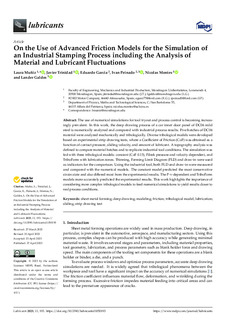| dc.rights.license | Attribution 4.0 International | |
| dc.contributor.author | Muñiz García, Laura | |
| dc.contributor.author | Trinidad Naranjo, Javier | |
| dc.contributor.author | GALDOS, Lander | |
| dc.contributor.other | García, Eduardo | |
| dc.contributor.other | Peinado, Iván | |
| dc.contributor.other | Montes, Nicolás | |
| dc.date.accessioned | 2024-02-02T08:53:13Z | |
| dc.date.available | 2024-02-02T08:53:13Z | |
| dc.date.issued | 2023 | |
| dc.identifier.issn | 2075-4442 (online) | |
| dc.identifier.other | https://katalogoa.mondragon.edu/janium-bin/janium_login_opac.pl?find&ficha_no=173013 | |
| dc.identifier.uri | https://hdl.handle.net/20.500.11984/6222 | |
| dc.description | Gobierno de España. CDTI. SMART EUREKA. IDI-20220061. Intelligent and sustainable stamping processes using hybrid control strategies together with process monitoring. iStamp | |
| dc.description.abstract | The use of numerical simulations for tool tryout and process control is becoming increasingly prevalent. In this work, the deep drawing process of a car inner door panel of DC06 mild steel is numerically analyzed and compared with industrial process results. Five batches of DC06 material were analyzed mechanically and tribologically. Diverse tribological models were developed based on experimental strip drawing tests, where a Coefficient of Friction (CoF) was obtained as a function of contact pressure, sliding velocity, and amount of lubricant. A topography analysis was defined to compare material batches and to replicate industrial tool conditions. The simulation was fed with three tribological models: constant (CoF 0.15), Filzek pressure and velocity dependent, and TriboForm with lubrication zones. Thinning, Forming Limit Diagram (FLD) and draw-in were used as indicators for the comparison. Using the industrial tool, both FLD and draw-in were measured and compared with the numerical models. The constant model predicted the most conservative strain state and also differed most from the experimental results. The P-v-dependent and TriboForm models more accurately predicted the experimental results. This work highlights the importance of considering more complex tribological models to feed numerical simulations to yield results closer to real process conditions. | en |
| dc.language.iso | eng | |
| dc.publisher | MDPI | |
| dc.rights | © 2023 The Authors | |
| dc.rights.uri | http://creativecommons.org/licenses/by/4.0/ | |
| dc.subject | sheet metal forming | en |
| dc.subject | deep drawing | en |
| dc.subject | modeling | |
| dc.subject | friction | |
| dc.subject | tribological model | |
| dc.subject | lubrication | |
| dc.subject | sliding | |
| dc.subject | strip drawing test | |
| dc.title | On the Use of Advanced Friction Models for the Simulation of an Industrial Stamping Process including the Analysis of Material and Lubricant Fluctuations | |
| dc.type | http://purl.org/coar/resource_type/c_6501 | |
| dcterms.accessRights | http://purl.org/coar/access_right/c_abf2 | |
| dcterms.source | Lubricants | |
| local.contributor.group | Procesos avanzados de conformación de materiales | es |
| local.description.peerreviewed | true | |
| local.identifier.doi | https://doi.org/10.3390/lubricants11050193 | |
| local.contributor.otherinstitution | FORD MOTOR COMPANY | |
| local.contributor.otherinstitution | https://ror.org/01tnh0829 | |
| local.source.details | Vol. 11. N. 5. N. art. 193, 2023 | |
| oaire.format.mimetype | application/pdf | |
| oaire.file | $DSPACE\assetstore | |
| oaire.resourceType | http://purl.org/coar/resource_type/c_6501 | |
| oaire.version | http://purl.org/coar/version/c_970fb48d4fbd8a85 | |
| oaire.funderName | Gobierno de España | |
| oaire.funderIdentifier | https://ror.org/038jjxj40 http://data.crossref.org/fundingdata/funder/10.13039/501100010198 | |
| oaire.fundingStream | CDTI. SMART EUREKA | |
| oaire.awardNumber | IDI-20220061 | |
| oaire.awardTitle | Intelligent and sustainable stamping processes using hybrid control strategies together with process monitoring (iStamp) | |
| oaire.awardURI | Sin información | |








